聚丙烯微塑料对重金属的吸附及共存特性研究
IF 2.8
4区 工程技术
Q2 CHEMISTRY, APPLIED
引用次数: 16
摘要
直径为5的塑料颗粒 mm或更小的称为微塑料。微塑料是环境污染的主要来源之一。已经证明微塑料也是重金属的载体,但对其吸附机理的研究很少。在本研究中,分析和讨论了聚丙烯(PP)微塑料对Pb、Cu、Cd和Zn的吸附。用扫描电子显微镜(SEM)观察了聚丙烯的形貌,用X射线光电子能谱(XPS)测定了聚丙烯的表面元素组成,并用傅立叶变换红外光谱(FTIR)分析了聚丙烯的官能团。结果表明,微塑料对不同重金属的吸附行为可以在32小时内达到平衡。动力学实验表明,两阶段动力学模型可以很好地拟合吸附过程,PP对Pb和Cu的吸附大于对Cd和Zn的吸附。Freundlich模型对Pb的吸附等温结果拟合效果最好。Langmuir模型表明,该过程有利于吸附。微塑料对混合重金属的吸附表明,当混合吸附质量浓度较低时,共存体系的存在促进了微塑料对Zn和Cu的吸附。随着浓度的增加,微塑料对4种重金属的吸附受到抑制。本文章由计算机程序翻译,如有差异,请以英文原文为准。
Coexistence and Adsorption Properties of Heavy Metals by Polypropylene Microplastics
Plastic particles with a diameter of 5 mm or less are called microplastics. Microplastics are one of the primary sources of pollution in the environment. It has been proven that microplastics are also carriers of heavy metals, but there are few studies on their adsorption mechanism. In this study, the adsorption of Pb, Cu, Cd, and Zn by polypropylene (PP) microplastics was analyzed and discussed. The morphology of PP was observed by scanning electron microscopy (SEM), the surface elemental composition of PP was determined by X-ray photoelectron spectroscopy (XPS), and the functional groups of PP were analyzed by Fourier transform infrared spectroscopy (FTIR). The results showed that the adsorption behavior of microplastics to different heavy metals could be balanced in 32 hours. Kinetics experiments showed that the adsorption process could be fitted well by a two-stage dynamic model, and the adsorption of Pb and Cu by PP is greater than that of Cd and Zn. The Freundlich model has the best fitting effect on Pb for the adsorption isothermal results. The Langmuir model showed that the process is favorable for adsorption. The adsorption of mixed heavy metals by microplastics showed that when the concentration of the mixed adsorption mass was low, the presence of a coexistence system promoted the adsorption of Zn and Cu by microplastics. With an increasing concentration, the adsorption of 4 heavy metals by microplastics is inhibited.
求助全文
通过发布文献求助,成功后即可免费获取论文全文。
去求助
来源期刊

Adsorption Science & Technology
工程技术-工程:化工
CiteScore
5.00
自引率
10.30%
发文量
181
审稿时长
4.5 months
期刊介绍:
Adsorption Science & Technology is a peer-reviewed, open access journal devoted to studies of adsorption and desorption phenomena, which publishes original research papers and critical review articles, with occasional special issues relating to particular topics and symposia.
 求助内容:
求助内容: 应助结果提醒方式:
应助结果提醒方式:


